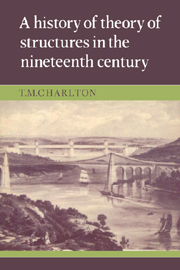Book contents
- Frontmatter
- Contents
- Preface
- 1 Introduction
- 2 Beam systems
- 3 Theory of the arch and suspension bridge
- 4 Elementary theory of frameworks: graphical statics
- 5 Theory of statically-indeterminate frameworks: the reciprocal theorem
- 6 Levy's theory of frameworks and bridge girders
- 7 Early developments of energy principles relating to theory of structures
- 8 The later development and use of energy principles
- 9 Applications of the least work principle: elastic theory of suspension bridges
- 10 Aspects of the further development of theory of structures
- 11 Secondary effects in structures
- Appendices
- Bibliography
- Name index
- Subject index
3 - Theory of the arch and suspension bridge
Published online by Cambridge University Press: 18 September 2009
- Frontmatter
- Contents
- Preface
- 1 Introduction
- 2 Beam systems
- 3 Theory of the arch and suspension bridge
- 4 Elementary theory of frameworks: graphical statics
- 5 Theory of statically-indeterminate frameworks: the reciprocal theorem
- 6 Levy's theory of frameworks and bridge girders
- 7 Early developments of energy principles relating to theory of structures
- 8 The later development and use of energy principles
- 9 Applications of the least work principle: elastic theory of suspension bridges
- 10 Aspects of the further development of theory of structures
- 11 Secondary effects in structures
- Appendices
- Bibliography
- Name index
- Subject index
Summary
At the beginning of the nineteenth century, to which elastic arch theory belongs, masonry was still the principal structural material. Many major structures, especially bridges, depended on the arch as a means of exploiting the strength of stone in compression. The origin of an explicit theory of the arch is variously ascribed to Hooke, De La Hire, Parent and David Gregory in the seventeenth century. Robison (Brewster, 1822) believed that Hooke suggested the inversion of the shape adopted by a suspended rope or chain, namely the catenary, as the statically correct form for an arch: others (Straub, 1952) ascribed that concept to David Gregory. In any event, it appeared to disregard a distribution of load different from that which would be due to a uniform voussoir arch. Heyman has reviewed the development of the theory of the arch in detail (1972) and leaves little doubt that it was highly developed in the eighteenth century. Coulomb's theory of 1773 (1776) of the distribution of force in loaded stone arches and their stability (ultimate load carrying capacity) was generally accepted by Navier, to judge by the contents of his Leçons (1826, 1833; in which, quite separately, elastic theory of the arch rib appears). But those youthful partners, Lamé & Clapeyron rediscovered (while in Russia) the theory of the ultimate strength of stone arches for themselves (1823), apparently ignorant of Coulomb's theory (or, indeed, that of Couplet which Heyman has described (1972)).
- Type
- Chapter
- Information
- Publisher: Cambridge University PressPrint publication year: 1982

